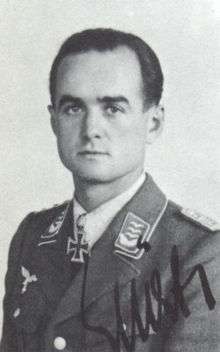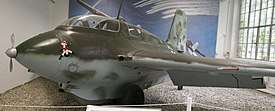Wolfgang Späte
Wolfgang Späte (8 September 1911 – 30 April 1997) was a German Luftwaffe fighter pilot during World War II. He was a recipient of the Knight's Cross of the Iron Cross with Oak Leaves. For fighter pilots it was a quantifiable measure of skill and combat success. He is attributed by some, for an early, 1938 version of the speed to fly theory,[1] usually attributed to Paul MacCready. Already a talented glider pilot before the war, he went on to become one of the Luftwaffe's foremost test pilots.
Wolfgang Späte | |
|---|---|
 Wolfgang Späte | |
| Born | 8 September 1911 Podersam, Sudetenland |
| Died | 30 April 1997 (aged 85) Edewecht, Germany |
| Allegiance | |
| Service/ | |
| Years of service | 1939–45 1956–67 |
| Rank | Major (Wehrmacht) Oberstleutnant (Bundeswehr) |
| Unit | JG 54, JG 400, JG 7 |
| Battles/wars | World War II |
| Awards | Knight's Cross of the Iron Cross with Oak Leaves |
| Other work | Bundeswehr |
Career
Späte was born on 8 September 1911 in Podersam. He participated in German invasion of the Balkans and Greece, he scored his first victory (a Yugoslav Bristol Blenheim, near Pecs in Hungary) on 7 April 1941.[2] Returning to the eastern frontier for Operation Barbarossa, he shot down two SB-2 bombers on 23 June, the second day of the invasion. Victories came regularly, and he was awarded the Ehrenpokal, for 25 victories, on 9 August. Soon after, on 10 September, he was promoted to Staffelkapitän of 5./JG 54. Then on 5 October, he became the 10th member of JG 54 to be awarded the Ritterkreuz (Knight's Cross), after reaching 45 victories. His unit withdrew to the Reich at the end of the year for rest and refit, and Späte was promoted to Hauptmann on 1 January 1942. Success continued upon returning to the north of the Eastern Front as the Soviets desperately tried to raise the siege of Leningrad. This culminated with the award of the Oakleaves to the Knight's Cross on 23 April 1942 when he had 72 victories.[3] However, with the award, he was ordered back to the Reich to set up a top-secret unit: Erprobungskommando 16, EKdo 16 - to test-fly the revolutionary new rocket-fighter, the Messerschmitt Me 163 "Komet".

Späte took his first flight in the Me 163 on 8 May 1942. Over the next year testing continued and slowly specially chosen pilots joined EKdo 16. Side by side with the rocket-fighter project, was the test programme of the Me 262 jet-fighter (under EKdo 262). Späte first flew the Me 262 on 17 April 1943, and is one of a select few pilots to have flown both ground-breaking aircraft.[4][5] After another year, the Me 163 was deemed combat-ready, and the testing program was wound down. Späte was promoted to Major and sent back to command a combat unit: IV./JG 54, currently based in Romania. Before he left for his new posting though, on 14 May 1944 he flew the first combat sortie for the Me 163. According to some sources, his Me 163 PK+QL was painted red, either in the factory or by ground crew, resembling Manfred von Richthofen's Fokker Dr.I. Although he flew the mission (without success, twice unable to intercept the enemy when the rocket engine failed), Späte was not amused after seeing the plane and ordered it to be re-painted.[6]
His new unit was quickly recalled to Germany in June to cover the transfer of all the squadrons sent west following the D-day landings. There it was converted onto the Fw 190A-8 and then sent to Poland against the great Russian summer offensive.[7] But against vastly greater numbers of enemy aircraft the unit was butchered, losing nearly half its pilots killed or wounded - Späte himself was injured and forced two times to bail out of his aircraft. The unit was pulled back again to the Reich for refit and rebuild. On 17 September, the Allied forces staged their airborne operation at Arnhem. Again, IV./JG 54 was thrown into the fray, but for the second time in less than 3 months, against vastly superior opposition, it was destroyed in less than a fortnight.[8]
Whether due to problems getting the Me 163 operational, or his unit's catastrophic losses, Späte gave up his command of IV./JG 54. In his 4-month absence from the Me 163 programme, the first combat unit (I./JG 400) had been set up and he joined that unit to come back up to speed on the interceptor's progress (some sources say as the unit's commander, although Hptm Robert Olejnik is also given as the unit commander at this time).[4][9]
In the last weeks of the World War 2 in Europe Späte and few of his most experienced rocket-pilots flew missions with Me 262 jet-figters at JG 7.
In 1956 he rejoined the military service in the Bundeswehr. Späte retired in 1967. He died in 1997 in Edewecht, at the age of 85.
Awards
- Ehrenpokal der Luftwaffe (9 August 1941)[10]
- German Cross in Gold on 9 December 1941 as Oberleutnant in the II./JG 54[11]
- Iron Cross (1939) 2nd Class (8 November 1939 & 1st Class (27 June 1940))[12]
- Knight's Cross of the Iron Cross with Oak Leaves
- Knight's Cross on 5 October 1941 as Oberleutnant of the Reserves and pilot in the 5./JG 54[13]
- 90th Oak Leaves on 23 April 1942 as Oberleutnant of the Reserves and Staffelkapitän of the 5./JG 54[13]
References
Citations
- Pettersson, Åke (Oct-November 2006). "Letters". Sailplane & Gliding (British Gliding Association) 57 (5): 6
- Weal 2001, pg. 39.
- Weal 2001, pg. 57.
- Smith & Creek 2005
- Forsyth 2008, pg. 9.
- Sundin & Bergström 1997, pg. 80.
- Weal 2001, pg. 109.
- Weal 2001, pg. 94.
- Luftwaffe Air Units: Single–Engined Fighters website.
- Obermaier 1989, p. 50.
- Patzwall & Scherzer 2001, p. 450.
- Thomas 1998, p. 332.
- Scherzer 2007, p. 711.
Bibliography
- Fellgiebel, Walther-Peer (2000) [1986]. Die Träger des Ritterkreuzes des Eisernen Kreuzes 1939–1945 — Die Inhaber der höchsten Auszeichnung des Zweiten Weltkrieges aller Wehrmachtteile [The Bearers of the Knight's Cross of the Iron Cross 1939–1945 — The Owners of the Highest Award of the Second World War of all Wehrmacht Branches] (in German). Friedberg, Germany: Podzun-Pallas. ISBN 978-3-7909-0284-6.
- Bergström, Christer & Mikhailov, Andrey (2001). Black Cross, Red Star Vol 2 Pacifica Military History. ISBN 0-935553-51-7
- Forsythe, Robert (2008). Aviation Elite Units #29: Jagdgeschwader 7 'Nowotny’. Oxford: Osprey Publishing Ltd. ISBN 978-1-84603-320-9
- Morgan, Hugh & Weal, John (1998). German Jet Aces of World War 2. Orsprey Publishing Limited. ISBN 1-85532-634-5, incl colour picture of his aircraft, #29
- Obermaier, Ernst (1989). Die Ritterkreuzträger der Luftwaffe Jagdflieger 1939 – 1945 [The Knight's Cross Bearers of the Luftwaffe Fighter Force 1939 – 1945] (in German). Mainz, Germany: Verlag Dieter Hoffmann. ISBN 978-3-87341-065-7.
- Patzwall, Klaus D.; Scherzer, Veit (2001). Das Deutsche Kreuz 1941 – 1945 Geschichte und Inhaber Band II [The German Cross 1941 – 1945 History and Recipients Volume 2] (in German). Norderstedt, Germany: Verlag Klaus D. Patzwall. ISBN 978-3-931533-45-8.
- Scherzer, Veit (2007). Die Ritterkreuzträger 1939–1945 Die Inhaber des Ritterkreuzes des Eisernen Kreuzes 1939 von Heer, Luftwaffe, Kriegsmarine, Waffen-SS, Volkssturm sowie mit Deutschland verbündeter Streitkräfte nach den Unterlagen des Bundesarchives [The Knight's Cross Bearers 1939–1945 The Holders of the Knight's Cross of the Iron Cross 1939 by Army, Air Force, Navy, Waffen-SS, Volkssturm and Allied Forces with Germany According to the Documents of the Federal Archives] (in German). Jena, Germany: Scherzers Militaer-Verlag. ISBN 978-3-938845-17-2.
- Smith, J.Richard & Creek, Eddie J (2005). “Jagdwaffe Vol 5, Sec4: Jet Fighters and Rocket Interceptors 1944 - 1945” Hersham, Surrey: Ian Allan Publishing ISBN 1-903223-52-0, incl colour picture of his aircraft, p. 310
- Späte, Wolfgang. Der streng geheime Vogel Me 163 (in German). DÖRFLER im NEBEL VERLAG GmbH. ISBN 978-3-89555-142-0.
- Sundin, Claes & Bergström, Christer (1997). Luftwaffe Fighter Aircraft in Profile. Altglen, PA: Schiffer Publishing. ISBN 0-7643-0291-4, incl colour picture of his aircraft, #71
- Thomas, Franz (1998). Die Eichenlaubträger 1939–1945 Band 2: L–Z [The Oak Leaves Bearers 1939–1945 Volume 2: L–Z] (in German). Osnabrück, Germany: Biblio-Verlag. ISBN 978-3-7648-2300-9.
- Weal, John (2001). Aviation Elite Units #6: Jagdgeschwader 54 ‘Grünherz’. Oxford: Osprey Publishing Ltd. ISBN 1-84176-286-5.
- Weal, John (2007). More Bf109 Aces of the Russian Front. Oxford: Osprey Publishing Ltd. ISBN 1-84603-177-X, incl colour picture of his aircraft, #29